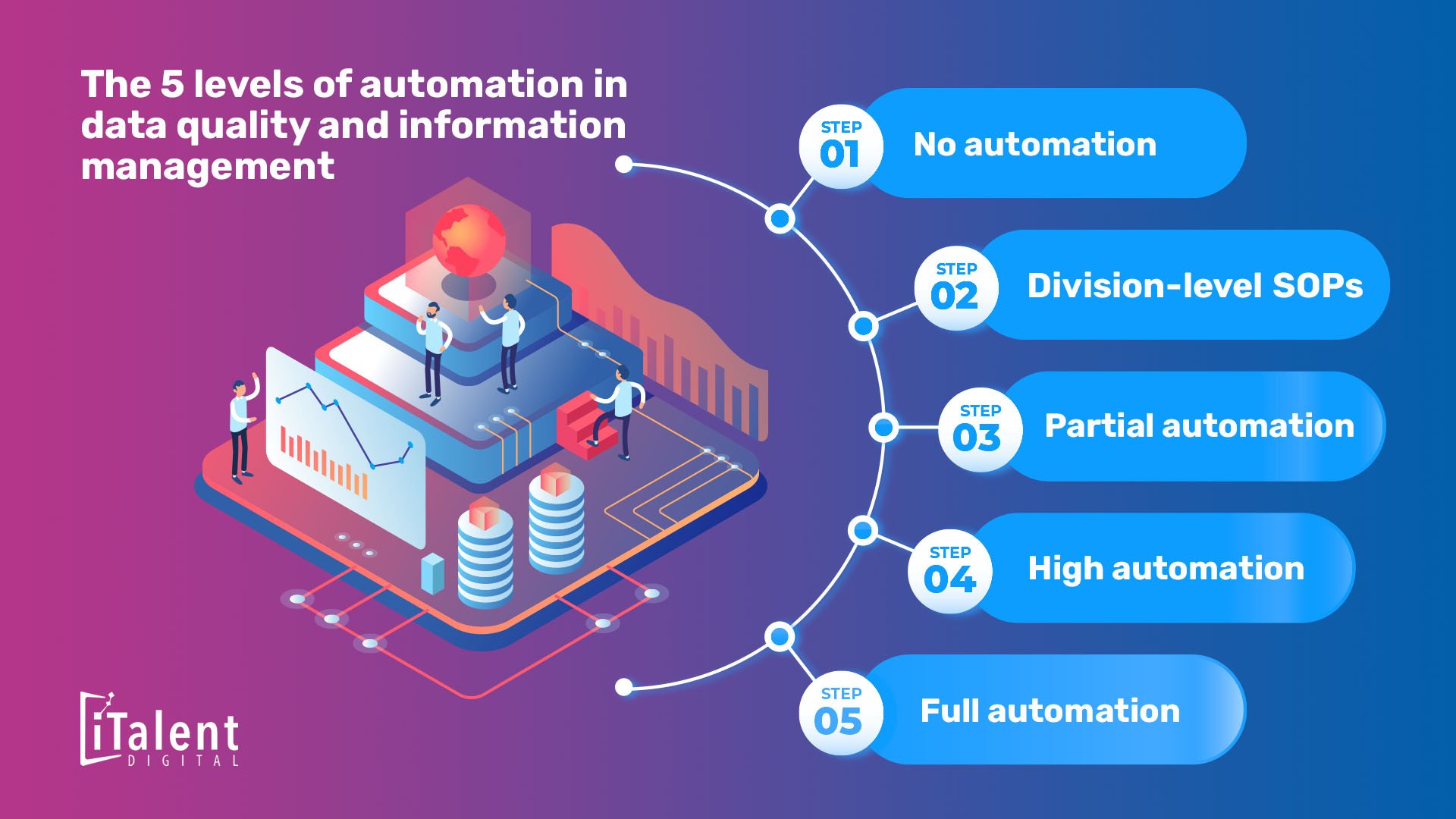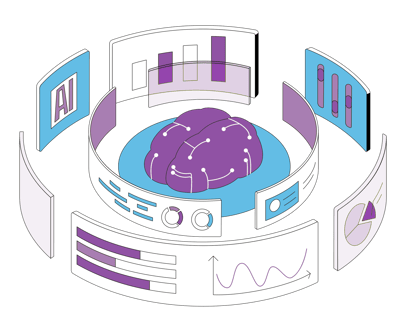The five levels of automation in data quality and information management—where does your organization stand?

Having advanced data quality and information management capabilities can be a strategic advantage in a digital-first world. As we engage with vast data sets in the pursuit of business and organizational goals, ensuring that data is accurate, accessible, and actionable is critical.
This is where the concept of data management maturity comes in: it is a measure of how well an organization manages its treasure trove of data to improve decision-making and edge out the competition.
Automation is the critical component that can transform data management from a mundane chore into a dynamic task that streamlines workflows and frees up human potential for higher-value tasks.
In this article, I walk through the five levels of automation in data quality and information management, pinpointing what each level entails and guiding you on how to level up your data management maturity.
Level 1: No automation
Let's begin at the stage of organizations that have yet to introduce any form of automation into their data quality and information management processes. This level is marked by an absence of systematic monitoring or controls over data quality, leaving data management largely to manual efforts and ad-hoc interventions.
Operating at this level carries significant risks and challenges. The lack of automation can lead to inconsistencies, inaccuracies, and inefficiencies in handling data. Organizations might find themselves grappling with unreliable datasets, which can skew decision-making and hinder operational effectiveness. A manual approach also eats up considerable time and resources while limiting organizational agility and responsiveness to data-driven opportunities.
The path to advancement begins with recognizing the need for change. Start by establishing basic data quality monitoring processes. This entails defining clear data quality standards and metrics that align with business objectives.
Implement simple automated tools for data validation to reduce errors and improve data reliability. Even basic automation can free up valuable time and allow teams to focus on more strategic tasks rather than getting bogged down by manual data quality checks.

Level 2: Division-level SOPs without automation
At this stage, the organization has taken a step toward formalizing its approach to data quality through standard operating procedures (SOPs) at the division level. These SOPs, however, are still being manually executed, with no automation in place to ensure data quality across the board.
While SOPs bring a level of order and consistency to data management practices within divisions, the lack of automation carries significant limitations. Relying on manual processes can lead to variability in data quality and management efficiency because some degree of human error and inconsistency is inevitable.
Manual processes struggle to scale with the volume and velocity of today's high-volume data environments, which can affect an organization's ability to reliably leverage its data for strategic decision-making. Automation brings increased consistency, accuracy, and efficiency to data handling.
To move up to level 3, begin by identifying repetitive, rules-based tasks within your data management SOPs that are ripe for automation. Implement basic automated tools for data validation, cleansing, and integration to significantly reduce manual workload and improve data quality. These steps enhance the reliability of your data across divisions and set the stage for more advanced automation and analytical capabilities.
Level 3: Partial automation
At this middle level, organizations begin to integrate automation into their data quality and information management processes. This automation is not comprehensive, though—only certain tasks and procedures are automated for enhanced efficiency and accuracy. It also lacks real-time data monitoring and analysis capabilities.
Partial automation marks a significant step forward in data management maturity by streamlining operations and reducing the potential for human error in key areas. Despite these advancements, the absence of real-time observation can create blind spots in data quality and information management. Organizations might not detect issues as they arise, delaying response times and potentially impacting decision-making and operational agility.
Advance to more comprehensive automation by adopting technologies that support real-time data monitoring and analysis. This includes tools equipped with event-driven architecture, streaming analytics, and dashboards that provide immediate insights into data quality and operational metrics.
Along with technological upgrades, develop and enforce policies that promote the further integration of automation across multiple processes. This includes establishing guidelines for data governance, quality standards, and continuous improvement processes. Encourage a culture that values data-driven insights and continuous innovation. This is crucial for utilizing automation fully and moving toward more advanced levels of data management maturity.
Level 4: High automation with limited observability tools
At this stage, the bulk of data quality processes within an organization have been automated. Despite this high degree of automation, however, the integration of cutting-edge data observability tools is still nascent. This limits the depth and immediacy of available insights.
The substantial level of automation achieved provides a solid foundation for data integrity and process efficiency, significantly reducing manual intervention and the associated risk of errors. The limited use of advanced observability tools, however, restricts an organization's ability to monitor data quality and system performance in real time. This gap may prevent the organization from achieving the full spectrum of benefits that automation can offer, such as immediate issue detection, predictive analytics, and enhanced decision-making capabilities.
To harness the full potential of data management automation, prioritize the adoption of advanced data observability tools. These tools offer comprehensive monitoring capabilities, from data lineage tracing to real-time performance analytics, enabling organizations to detect and address issues proactively. Integrate such tools into the data management ecosystem for deeper insights, improved data reliability, and a more responsive data infrastructure.
Evaluate and select observability platforms that align with your specific data architecture and operational needs. Train teams on these new technologies and develop policies that support proactive data quality monitoring.
Level 5: Full automation with advanced observability
This is the final level of automation and data management maturity, where organizations have achieved a fully automated ecosystem for data quality and information management. Cutting-edge data observability tools have now been seamlessly woven into the core of data processes to guarantee extensive monitoring and analytical capabilities.
Attaining this level of automation and observability translates into a host of transformative benefits for an organization. Decision-making becomes markedly more informed and agile as real-time data insights guide strategic moves and adjustments. Operational efficiency reaches new heights, with automated systems streamlining workflows and reducing the need for manual oversight. This level of data management maturity offers a competitive edge and positions the organization as a forward-thinking leader in leveraging data for strategic advantage.
The technological backbone supporting this advanced stage of automation is a sophisticated array of tools and frameworks. AI and machine learning (ML) algorithms play a crucial role in automating complex data analysis tasks and predicting trends with high accuracy. Data observability platforms offer granular insights into data health, lineage, and performance for the proactive management of data ecosystems. Comprehensive data governance frameworks ensure that data quality and management practices align with organizational standards and regulatory requirements.
Implementing these higher-end data automation technologies requires a commitment to continuous learning and adaptation as well as a culture that values data-driven insights and innovation. Embrace these key technologies and capabilities to unlock the full potential of your data assets and drive growth and success.
Where does your organization stand?
From the foundational level of no automation to the pinnacle of fully automated systems with advanced observability, each step forward marks a stride toward operational excellence and strategic insight.
The journey through these levels illuminates a path to the heart of organizational agility and competitive advantage. The benefits of advanced automation maturity are clear: improved decision-making, greater operational efficiency, and a robust strategic position in the digital marketplace.
Curious about how your organization measures up? Compare your data quality automation maturity with that of world-class enterprises using our online data management maturity assessment. Understanding where you stand is the first step toward unlocking the full potential of your data assets.
Contact me at itbi@italentdigital.com today to begin your journey toward data management excellence and harness the transformative power of automation! Learn more about our BI, Data and Analytics Practice.
You may also like:
The five levels of data visualization and reporting maturity – how does your organization stack up?
Embrace a holistic approach to customer obsession
The best technology for optimizing business intelligence




